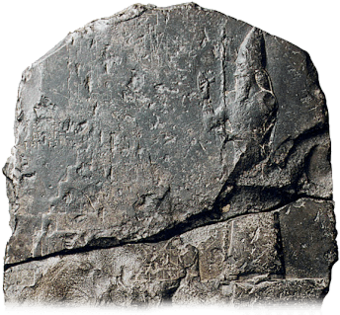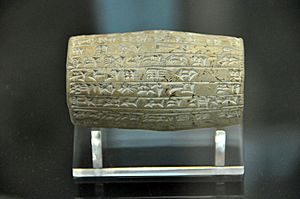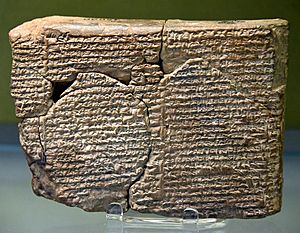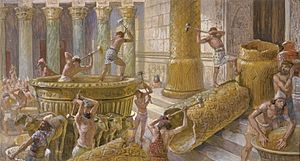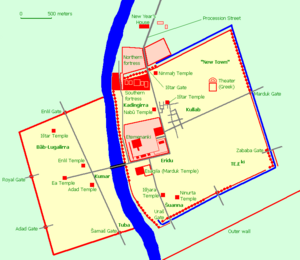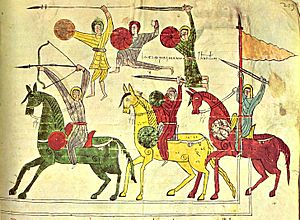Nebuchadnezzar II facts for kids
Quick facts for kids Nebuchadnezzar II |
|
|---|---|
|
|

Portion of the so-called "Tower of Babel stele", depicting Nebuchadnezzar II on the right and featuring a depiction of Babylon's great ziggurat (the Etemenanki) to his left
|
|
| King of the Neo-Babylonian Empire | |
| Reign | August 605 BC – 7 October 562 BC |
| Predecessor | Nabopolassar |
| Successor | Amel-Marduk |
| Born | c. 642 BC Uruk (?) |
| Died | 7 October 562 BC (aged c. 80) Babylon |
| Spouse | Amytis of Babylon (?) |
| Issue Among others |
|
| Akkadian | Nabû-kudurri-uṣur |
| Dynasty | Chaldean dynasty |
| Father | Nabopolassar |
Nebuchadnezzar II (whose name in ancient Babylonian was Nabû-kudurri-uṣur, meaning "Nabu, watch over my heir") was a famous king of the Neo-Babylonian Empire. He ruled for 43 years, from 605 BC to 562 BC. This made him the longest-reigning king of his family, the Chaldean dynasty. Many people consider him the greatest king of the Neo-Babylonian Empire.
Nebuchadnezzar is well-known for his military victories in the Levant (an area in the Middle East). He also built many amazing structures in his capital city, Babylon. He played a very important part in Jewish history. When he died, Nebuchadnezzar was one of the most powerful rulers in the world.
He might have been named after his grandfather, or after an earlier warrior-king named Nebuchadnezzar I. Even before he became king, Nebuchadnezzar II was famous. He led armies during the war against the Neo-Assyrian Empire. At the Battle of Carchemish in 605 BC, he defeated the Egyptian army. This victory helped the Neo-Babylonian Empire become the strongest power in the ancient Near East.
After this big win, his father, Nabopolassar, died. Nebuchadnezzar then became king. His early years as king were not as successful in war. He even failed to invade Egypt. This made some of Babylon's vassal states (smaller kingdoms under Babylon's control) doubt its power. Some people even rebelled against him.
But Nebuchadnezzar's luck changed. In the 580s BC, he won many battles in the Levant. He wanted to stop Egypt from having too much influence there. In 587 BC, he destroyed the Kingdom of Judah and its capital, Jerusalem. This event led to the Babylonian captivity, where many people from Jerusalem were taken to Babylonia. The Jewish people saw Nebuchadnezzar as a "destroyer of nations." The biblical Book of Jeremiah even says he was God's chosen ruler to punish disobedience. By destroying Jerusalem and capturing the city of Tyre, Nebuchadnezzar made his empire the new superpower of the ancient Near East.
Besides his military achievements, Nebuchadnezzar was also a great builder. His successful wars brought wealth, which he used for huge building projects. He rebuilt many religious buildings in Babylon, like the Esagila and Etemenanki (a huge tower). He also fixed his old palace and built a new one. He made the city's Processional Street and the Ishtar Gate much more beautiful. Because most of his writings talk about building, historians once thought he was mainly a builder, not a warrior.
Contents
Who Was Nebuchadnezzar II?
What Does His Name Mean?
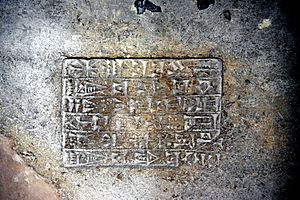
Nebuchadnezzar II's name in the Akkadian was Nabû-kudurri-uṣur. This means "Nabu, watch over my heir." Nabu was a Babylonian god. Some older ideas suggested it meant "Nabu, protect the boundary." But most historians now agree on "watch over my heir."
The name is usually shortened to 'Nebuchadnezzar' in English. This comes from how it was written in Hebrew and Greek, especially in the Bible. Some scholars prefer "Nebuchadrezzar" because it is closer to the original Akkadian. This version is found in parts of the Bible, like the books of Jeremiah and Ezekiel.
Nebuchadnezzar II had the same name as an earlier king, Nebuchadnezzar I. That king ruled over 500 years before him. Both were famous warrior-kings. They both appeared during difficult times and defeated Babylon's enemies. It is possible Nebuchadnezzar II was named after his grandfather, who also had the same name.
His Family and Early Life

Nebuchadnezzar was the oldest son of Nabopolassar. Nabopolassar founded the Neo-Babylonian Empire. He started a rebellion against the Neo-Assyrian Empire. This war freed Babylonia from Assyrian control. It also led to the complete destruction of Assyria. The new Neo-Babylonian Empire was powerful but still a bit unstable.
Nabopolassar's family might have come from the city of Uruk. Nebuchadnezzar himself was a high priest of the Eanna temple in Uruk from 626/625 BC to 617 BC. He was very young when he became a high priest.
Nebuchadnezzar as a Young Prince
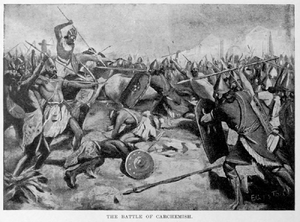
Nebuchadnezzar started his military career during his father's rule. He helped his father capture the city of Harran in 610 BC. This victory in 609 BC ended the ancient Assyrian monarchy forever.
Egypt, led by Pharaoh Necho II, tried to help Assyria. Necho wanted Assyria to remain a buffer between Egypt and the growing Babylonian and Median kingdoms. The Egyptians took control of the Levant and set up their base at Carchemish in Syria.
Nebuchadnezzar's biggest victory as a prince was at the Battle of Carchemish in 605 BC. He was the sole commander of the Babylonian army. His father stayed in Babylon, possibly due to illness. Nebuchadnezzar completely crushed the Egyptian forces. Babylonian records say not a single Egyptian escaped.
This victory was so important that it is mentioned in the Bible, in the Book of Jeremiah and the Books of Kings. It meant that all of Syria and Palestine came under Babylonian control. The defeat of Egypt at Carchemish made the Neo-Babylonian Empire the main power in the ancient Near East. It became the true successor to the Neo-Assyrian Empire.
Nebuchadnezzar's Rule as King
Becoming King
Nabopolassar died just weeks after Nebuchadnezzar's victory at Carchemish. Nebuchadnezzar was still fighting the Egyptians. He quickly made peace with them and rushed back to Babylon. He was crowned king in mid-August. He returned so quickly to prevent any of his brothers from trying to take the throne.
One of his first acts was to bury his father. Nabopolassar was placed in a grand coffin, decorated with gold. Soon after, Nebuchadnezzar went back to Syria to continue his campaigns. He faced little resistance and returned to Babylon with plunder. However, he had not yet fully gained the loyalty of the western states in the Levant.
Early Military Actions
The Babylonian Chronicle tells us about Nebuchadnezzar's first eleven years as king. In 604 BC, he campaigned in the Levant again. He conquered the city of Ashkelon. Its king was captured and taken to Babylon. The city was plundered and destroyed. Modern digs confirm this destruction. Before this, he had a successful campaign in Syria, where rulers of Phoenicia swore loyalty to him.
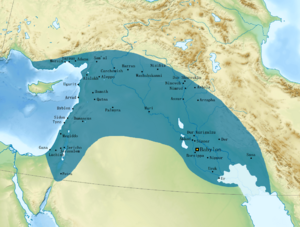
In 601 BC, Nebuchadnezzar marched his army into Egypt. This was a risky move, but he wanted to show Babylonian power. The invasion failed, and both armies suffered many losses. However, it did stop Egypt from interfering in the Levant for a while. In 599 BC, he raided Arab tribes in the Syrian desert.
In 598 BC, Nebuchadnezzar attacked the Kingdom of Judah. He captured Jerusalem in 597 BC. Judah's king, Jehoiakim, had challenged Babylonian rule. Jehoiakim died during the siege. His son, Jeconiah, was captured and sent to Babylon. Nebuchadnezzar then put Zedekiah on the throne as the new king of Judah. Jeconiah was kept alive in Babylonia and even received food from Nebuchadnezzar's palace.
There were some years with little military action. For example, in 600 BC, Nebuchadnezzar stayed in Babylon to "refit his numerous horses and chariotry." Some of his victories were not major challenges. His failure to conquer Egypt and other less successful campaigns made Babylon seem like a "paper tiger" to some. This meant it was seen as a threat that was not as strong as it appeared.
The Fall of Jerusalem
King Zedekiah of Judah waited for a chance to break free from Babylon. After Pharaoh Necho II died, Egypt's new pharaohs, Psamtik II and Apries, encouraged rebellions against Babylon. Zedekiah openly rebelled against Nebuchadnezzar.
In 589 BC, Zedekiah refused to pay tribute. The king of Tyre, Ithobaal III, also rebelled. In response, Nebuchadnezzar conquered and destroyed the Kingdom of Judah in 586 BC. This was one of his greatest achievements. Jerusalem was plundered and destroyed. Many Jewish people were captured and taken to Babylonia in the Babylonian captivity. Archeological digs confirm that Jerusalem and the surrounding area were destroyed. Nebuchadnezzar might have used a "scorched earth" policy to stop Egypt from gaining control there.
Zedekiah tried to escape but was captured near Jericho. Nebuchadnezzar wanted to make an example of him. Zedekiah was forced to watch his sons be executed. Then, his eyes were gouged out, and he was sent to prison in Babylon. The siege of Jerusalem lasted a long time, about 18–30 months. This was longer than typical wars in Mesopotamia.
Later Military Actions
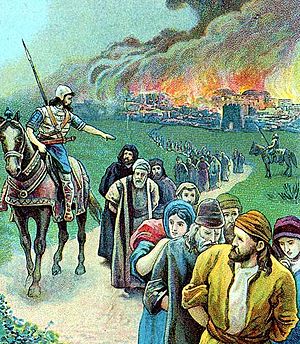
Tyre had also rebelled against Nebuchadnezzar. He moved to retake the city after conquering Judah. The biblical Book of Ezekiel suggests Tyre was captured around 571 BC. The siege of Tyre is said to have lasted 13 years by some ancient writers. This long siege was likely due to Tyre being on an island. It was hard to capture without naval support.
In the end, Tyre was not conquered by battle. Its king and Nebuchadnezzar reached an agreement. Tyre would continue to be ruled by vassal kings, but under stricter Babylonian control. Documents show Tyre became a center for Babylonian military actions in the region.
Nebuchadnezzar's campaigns in the Levant, especially against Jerusalem and Tyre, changed the Neo-Babylonian Empire. It went from being a smaller state to the new dominant power in the ancient Near East. However, his empire's size did not grow much by the end of his reign. He also never managed to conquer Egypt. His greatest victory remained the Battle of Carchemish, which happened before he even became king.
Nebuchadnezzar's Building Projects
Babylonian kings were traditionally known for building and restoring. Large building projects were important to show a ruler's power. Nebuchadnezzar greatly expanded and rebuilt his capital city, Babylon. The city we imagine today is mostly how it looked after his projects. These projects were possible because his conquests brought great wealth.
His building records show work on many temples. He restored the Esagila, the main temple of Babylon's god Marduk. He also finished the Etemenanki, a huge ziggurat (a stepped tower) dedicated to Marduk.
He also worked a lot on civil and military buildings. One impressive project was around the city's northern entrance, the Ishtar Gate. He restored the South Palace and built a completely new North Palace. He also fixed Babylon's Processional Street and the gate itself. The restored Ishtar Gate was decorated with blue and yellow bricks. It had pictures of bulls (symbols of the god Adad) and dragons (symbols of Marduk). The Processional Street also had pictures of lions (symbols of the goddess Ishtar).
Nebuchadnezzar also worked on the city of Borsippa. He restored its temple, the Ezida, dedicated to the god Nabu. He also repaired Borsippa's walls.
Other big projects included the Nar-Shamash, a canal to bring water from the Euphrates river. He also built the Median Wall, a large defensive structure. This wall protected Babylonia from attacks from the north. He also started the Royal Canal, which linked the Euphrates to the Tigris river. This canal greatly improved farming in the region. It was finished by a later king, Nabonidus.
End of His Reign
Nebuchadnezzar died in Babylon in 562 BC. He had ruled for 43 years, the longest of his dynasty. The Babylonians remembered him fondly.
His son, Amel-Marduk, became king after him. Amel-Marduk was not Nebuchadnezzar's oldest living son. It is unclear why he was chosen. Some records suggest Nebuchadnezzar and Amel-Marduk had a difficult relationship. Amel-Marduk was even imprisoned by his father at one point. It is possible Nebuchadnezzar wanted to choose another son as his heir but died before he could.
Family and Children
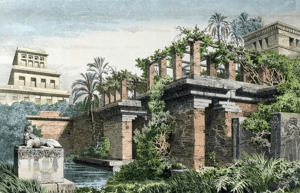
No Babylonian records tell us the name of Nebuchadnezzar's wife. But an ancient writer named Berossus says her name was Amytis. She was the daughter of the Median king Cyaxares. This marriage helped seal the alliance between the Babylonians and the Medes. Legend says Nebuchadnezzar built the Hanging Gardens of Babylon for Amytis. These gardens were one of the Seven Wonders of the Ancient World. He supposedly built them to make her feel less homesick for the mountains of Media. However, no archaeological proof of these gardens has been found yet.
Nebuchadnezzar had six known sons:
- Marduk-nadin-ahi (Akkadian: Marduk-nādin-aḫi) – He was likely Nebuchadnezzar's firstborn son. He is mentioned in documents from as early as 602/601 BC and as late as 563 BC.
- Eanna-sharra-usur (Akkadian: Eanna-šarra-uṣur) – Mentioned as a "royal prince" in 587 BC.
- Amel-Marduk (Akkadian: Amēl-Marduk) – He became king after Nebuchadnezzar. He ruled for only two years before being murdered.
- Marduk-shum-usur (Akkadian: Marduk-šum-uṣur) – Mentioned as a "royal prince" in 564 BC and 562 BC.
- Mushezib-Marduk (Akkadian: Mušēzib-Marduk) – Mentioned as a "royal prince" in 563 BC.
- Marduk-nadin-shumi (Akkadian: Marduk-nādin-šumi) – Mentioned as a "royal prince" in 563 BC.
He also had three known daughters:
- Kashshaya (Akkadian: Kaššaya) – She is mentioned in several documents as "the king's daughter." She lived in Uruk. Many historians believe she married Neriglissar, who later became king.
- Innin-etirat (Akkadian: Innin-ēṭirat) – She is mentioned in a 564 BC document. She likely lived in Uruk.
- Ba'u-asitu (Akkadian: Ba'u-asītu) – She owned land and is believed to have lived in Uruk.
It is possible that one of Nebuchadnezzar's daughters married Nabonidus, who became the last king of the Neo-Babylonian Empire. This marriage might explain why some later stories, like the Book of Daniel, say that Nabonidus's son, Belshazzar, was Nebuchadnezzar's descendant.
Nebuchadnezzar's Legacy
How Historians See Him
Historians' views of Nebuchadnezzar have changed over time. He is generally seen as the greatest king of the Neo-Babylonian Empire.
Nebuchadnezzar's own writings do not talk much about his wars. This is different from earlier Assyrian kings. For a while, historians thought he was mainly a builder. But after new historical records were found in 1956, historians realized he was also a great warrior.
Historian Josette Elayi said in 2018 that Nebuchadnezzar is hard to fully understand. She wrote that he was a conqueror and a great builder. He successfully built the Babylonian Empire and restored a country damaged by war.
In Jewish and Biblical Stories

The Babylonian captivity, started by Nebuchadnezzar, ended when Cyrus the Great conquered Babylon in 539 BC. Even after being freed, the Jewish people remembered their time in captivity. The Book of Jeremiah calls Nebuchadnezzar a "lion" and a "destroyer of nations."
The Bible tells how Nebuchadnezzar destroyed Judah and Jerusalem. He took the Jewish people captive. He is shown as a cruel enemy. However, the Bible also says that God appointed Nebuchadnezzar to rule the world. It says Judah should have obeyed him. Nebuchadnezzar's conquests are shown as part of God's plan.
Interestingly, the Book of Jeremiah calls Nebuchadnezzar "my servant" (meaning God's servant) in three places. This is unusual because he was an enemy of God's chosen people. This might mean he was seen as an instrument of God's plan. Or it could be a later addition to the text.

In the Book of Daniel, Nebuchadnezzar is shown differently. He is often a merciless and despotic ruler. In one story, he demands his wise men interpret a dream without telling them what it was. When they cannot, he sentences them to death. But when Daniel interprets the dream, Nebuchadnezzar is grateful. He gives Daniel gifts and makes him a governor.
In another story, Nebuchadnezzar throws three men into a furnace for not worshipping his golden statue. They are miraculously saved. Nebuchadnezzar then admits God is the "lord of kings." But he also says anyone who speaks badly of God will be "cut in pieces." This shows him as a powerful, sometimes inconsistent, ruler.
A third story in Daniel says Nebuchadnezzar will lose his mind and live like an animal for seven years. This part of the story might actually be based on Nabonidus, the last king of Babylon. Later traditions sometimes mixed up Nebuchadnezzar with other rulers.
The Book of Judith also mentions Nebuchadnezzar. It calls him a king of the Assyrians, not Babylonians. This book shows he was still seen as an evil king who destroyed Jerusalem and took the Jewish people captive.
Other Mentions
Some medieval scholars, like al-Ṭabarī, called Nebuchadnezzar Buḫt Nuṣṣur. They credited him with conquering Egypt, Syria, Phoenicia, and Arabia. However, the real Nebuchadnezzar never conquered Egypt. It seems al-Ṭabarī gave him achievements of other kings.
Titles of Nebuchadnezzar
Nebuchadnezzar used several titles. Most often, he was called "Nebuchadnezzar, king of Babylon, son of Nabopolassar, king of Babylon." He also used titles like "the one who provides for Esagil and Ezida." In some documents, he was called "king of the Universe" and "king of Sumer and Akkad." These were ancient titles used by many Babylonian kings.
Images for kids
-
Statue probably depicting Pharaoh Necho II of Egypt, who was defeated at Carchemish by Nebuchadnezzar in 605 BC, but fought off Nebuchadnezzar's invasion of Egypt in 601 BC
See also
 In Spanish: Nabucodonosor II para niños
In Spanish: Nabucodonosor II para niños
- List of biblical figures identified in extra-biblical sources
- Nebuchadnezzar (Blake) – a famous 19th-century painting about the biblical story of Nebuchadnezzar's madness
- Nabucco – a 19th-century opera by Giuseppe Verdi, based loosely on the biblical story of Nebuchadnezzar


